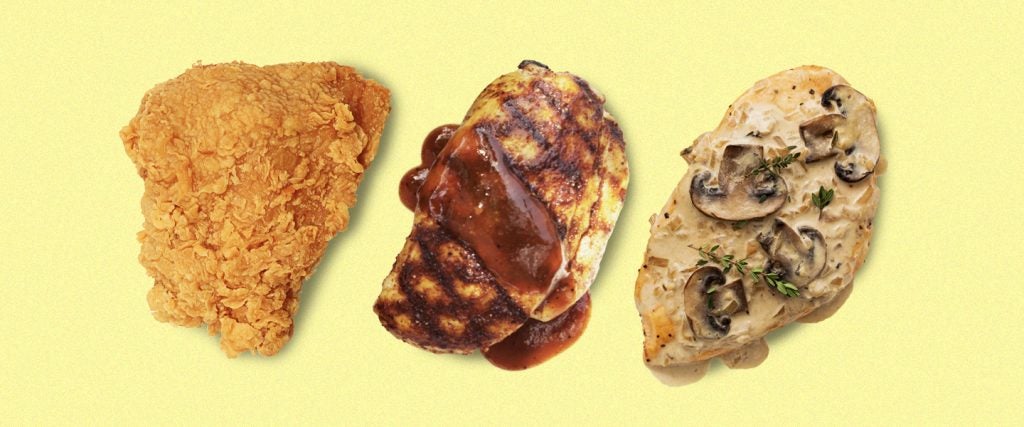When it comes to absorbing critical information, I’ve always been more of a visual learner, and my education in healthy eating was no different. In this instance, no matter how many times I may have scanned the pages of Muscle & Fitness, the ubiquity of chicken as the preferred muscle-building protein of champions had escaped me until I was hanging out at the townhouse of Chris, a fellow Bally Total Fitness personal trainer. As we chatted, I followed him into the kitchen and watched as he pulled a tray bearing eight chicken breasts out of the oven.
“I thought we were ordering pizza,” I objected.
“We’re not eating this tonight,” Chris laughed. “This is my lunch for the week.”
“The whole week?!?!” I asked. “You’re going to each chicken breast every day?”
“With rice,” Chris added.
“Why chicken breast?” I prodded.
“It’s cheap, it’s low in fat and it’s easy to cook,” Chris responded.
You never forget the first time you watch a dude meal prep that much poultry, and it remained firmly lodged in my head thereafter that chicken should be the first meat you should reach for if the goal is to scarf down large quantities of a healthy animal protein without breaking the bank.
Is chicken breast always healthy no matter what you do to it?
That’s a bit of a trick question, because the chicken is essentially an innocent victim in the culinary crimes being perpetrated against it. It’s what you add to the chicken — by way of flavoring, seasoning, saucing or cooking methods — that can debase its high-protein, low-fat essence.
All by its lonesome, a chicken breast of average size can range from 200 to 285 calories and 35 to 55 grams of protein, along with 4 to 8 grams of fat and a natural sodium level of 90 to 120 milligrams. If you took this plain, unseasoned chicken breast, grilled it and ate it without either seasonings or sauces, this is what you’d be getting out of it.
In what ways do I tamper with the health of my chicken by cooking it?
Breading it and deep-frying it is an excellent start. If you’ve ever consulted a KFC menu, it’s plain to see that the “extra” and “crispy” inclusions in the extra-crispy chicken consist primarily of heavy breading, seasoning and a mountain of salt, before the newly armored chicken is plunged into boiling oil, like a troublesome serf would be disposed of by an evil oligarch in medieval times. The breading alone adds 140 calories and 14 more grams of fat to a chicken breast that would have already charted at 390 calories and 21 grams of fat if all you did was deep fry it.
For the record, the grilled chicken breast once offered by KFC was only 210 calories. Granted, its 710 milligrams of sodium was almost a third of the USDA recommended intake level, but that’s nothing compared to the sodium levels of the original and extra-crispy fried chicken variants, both of which contain north of 1,150 salty milligrams.
What about any sauce I add to it?
It all depends on which sauce, and how much has been added. Many of your favorite barbecue sauces will derive nearly 100 percent of their caloric values from sugar. I always loved it when my dad would dump half a bottle of barbecue sauce on his chicken or pork and then have the nerve to act as if it had only been two tablespoons. (“Dad… the Open Pit bottle is half-empty already!”) What he did is a great way to take two pieces of otherwise benign chicken breast and raise their calorie count by 170 calories each — if you can actually sop up all that sauce with them.
Also, if you’re one of those folks talented enough to prepare your own syrupy, honey-glazed variant of anything, you’re essentially taking a chicken breast — whether it’s fried or not — and decorating it with sugar. Don’t allow the “natural” branding of honey to distract you from the fact that its glycemic index score of 58 is only negligibly lower than the 60 scored by raw sugar. It’s going to spike your insulin levels, especially if it’s paired with a fiberless food like chicken.
And so, my advice would be to consume your chicken in as close to its natural state as possible, using the bare minimum amount of salt and seasonings to make it more enjoyable (shocking, I know). Because when you transform chicken into a deep-fried protein pastry and then add sugar on top of it, no amount of intrinsic healthiness can save it. In fact, you’re just playing a different game of chicken.

